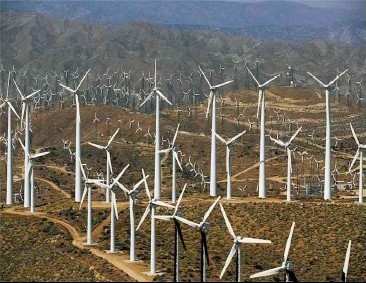Wed, Sep 08, 2010
Raytheon, NATS Work To Develop New Hardware, Processing
Several times over the past year, ANN has reported on stories in
which proposed windfarms have come into conflict with the nation's
air traffic system. One of the most common problems is radar
interference caused by the giant, spinning blades of the wind
turbines which are, in some cases, indistinguishable from aircraft.
Some claim that air traffic concerns are stunting the growth of
wind power in the United States.

Putting a set of turbines across an area can look like a "great
field of moving objects," according to Raytheon Digital Airport
Surveillance Radar technical director Peter Drake. "It's a very
real problem." He said that in addition to the spinning blades
appearing to be aircraft on radar screens, the interference can
cause a legitimate target to suddenly shift its position.
The online technology magazine CNET reports that Raytheon and
Europe's National Air Traffic Services have been collaborating on
potential mitigations of the interference for the past two years.
Raytheon Canada general manager Brian Smith said some of the same
techniques being developed overseas could be applicable to the U.S.
as well. One such solution is called concurrent beam processing,
which allows radar systems to differentiate between targets in the
air and ground clutter. Another involves more detailed terrain maps
that allow stationary turbines to be screened out, leaving only the
moving objects.
But these and other potential solutions to the problem require
upgrading the radar hardware to allow it to process more data along
with software updates. Smith says he is confident that the partners
have come up with workable fixes.
Turbine manufacturers are reportedly doing their part as well,
working on "stealth" technology that would reduce the radar
signature of the devices. But Gary Siefert at the Idaho National
Laboratories, a recognized expert on wind-radar conflicts, says
most of the windfarms will have to be addressed on a case-by-case
basis. "Anybody who says they can solve all the problems is
probably overstating," he said.
More News
Aero Linx: JAARS Nearly 1.5 billion people, using more than 5,500 languages, do not have a full Bible in their first language. Many of these people live in the most remote parts of>[...]
'Airplane Bounced Twice On The Grass Runway, Resulting In The Nose Wheel Separating From The Airplane...' Analysis: The pilot reported, “upon touchdown, the plane jumped back>[...]
"Burt is best known to the public for his historic designs of SpaceShipOne, Voyager, and GlobalFlyer, but for EAA members and aviation aficionados, his unique concepts began more t>[...]
"Polaris Dawn, the first of the program’s three human spaceflight missions, is targeted to launch to orbit no earlier than summer 2024. During the five-day mission, the crew >[...]
There Are SO Many Ways To Get YOUR Aero-News! It’s been a while since we have reminded everyone about all the ways we offer your daily dose of aviation news on-the-go...so he>[...]
 ANN's Daily Aero-Linx (05.04.24)
ANN's Daily Aero-Linx (05.04.24) NTSB Final Report: Quest Aircraft Co Inc Kodiak 100
NTSB Final Report: Quest Aircraft Co Inc Kodiak 100 Aero-News: Quote of the Day (05.04.24)
Aero-News: Quote of the Day (05.04.24) Aero-News: Quote of the Day (05.05.24)
Aero-News: Quote of the Day (05.05.24) Read/Watch/Listen... ANN Does It All
Read/Watch/Listen... ANN Does It All



